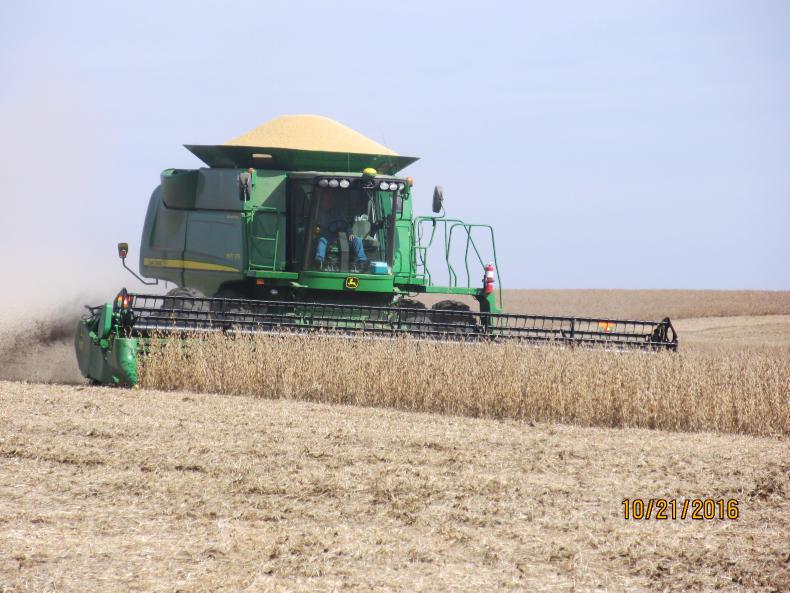Can I first say that we really enjoyed the company of our first Irish intern, Denis Dunne from Rathangan, last season.
We think he enjoyed his time here also as he is back out on vacation with us at the moment before returning to UCD to finish his degree in agriculture.
We are equally glad to know that we have another Irish intern about to arrive. We look forward to welcoming Stephen Robb from Donegal who will join us for harvest and beyond.
Those Irish farm lads are making a lasting impression here in Missouri and we look forward to Stephen’s arrival.
Dryness concern
We made good progress on planting here this spring, having got off to a relatively early start, and we got favourable conditions most of the way through. However, others to the south and east of us had a somewhat more trying time for planting.
Weather here was dry for the first 30 days after planting so we had good establishment. We got a little rain in July but then it was back to dry conditions for August.
Rainfall levels have also been quite variable. On one of my corn plots, the east side received 8.75in (222.25mm) since planting, while the west side of the plot received 11.75in (298.45mm).
The distance from the east to west side is only 0.5 miles, but I have seen this happen before. I had hoped for a little more rain but it is what it is and we can’t change it.
At the moment it looks like soya beans are set for around average yield. These could also do with a little more rain but they still have a month or two of growing to do so there is still scope for optimism. As of now I am projecting about 50-60 bu/ac (1.36-1.63t/ac).
Dicamba issue
One big current issue for us here relates to dicamba damage. On our farm we have had about 400 acres of soya beans for seed damaged by the re-volatilisation of dicamba.
The use of dicamba for weed control in tolerant soya bean varieties is now associated with damage to soya beans, fruit trees, gardens, flowers, trees, shrubs etc.
It has been a huge issue this year and has neighbour against neighbour.
Dicamba resistance is a trait that has been bred into some soya beans to help cope with glyphosate-resistant weeds. So dicamba can be used on these tolerant varieties but damage is occurring on other non-tolerant beans plus other neighbouring crops.
Missouri has about 300,000 acres of damage on record but it is probably much higher.
Recent University estimates suggested about 3.5 million acres damaged in the US. My belief is that this is much closer to five million acres.
Growers feel the technology was not field-proofed before it was introduced and that some of the active applied has the ability to re-volatilise in the days following treatment.
This can then be taken in air currents and deposited to surrounding areas to damage non-target crops. And these problems are occurring despite a range of use restrictions being imposed on growers with regard to application time, wind speed and direction, temperature, water rate, buffer zones etc.
Damage has been recorded from between two and 15 miles for the treated field and it can occur a number of days post-treatment.
It is also causing damage to treated crops as it can slow or stop plant growth for two to three weeks. This can result in delayed maturity, possible yield decrease and affect germination levels in seed crops.
Price pressure
Grain prices are dismal at best. Corn is in the $3.30/bu (€110/t) elevator price range in recent weeks.
Beans are actually holding up better because of export demand, with local price around $9.30/bu (€291/t). If it were not for the lower dollar value and exports, beans would be $1/bu lower.
Machinery dealers are crying the blues also, as there is not much moving due to current price levels.
With corn in the $3/bu range, it is difficult to afford a combine priced in the $450,000 to $550,000 range.
Used machines are discounted too and the lack of this trade is not helping to offset the cost of buying new.
New-season fertiliser prices are still too high. Summer offers for anhydrous ammonia were at $375/t (82%N) (€319/t or €0.389/kgN). Last year we bought this for $400/t in late December.
P and K prices are back slightly on last season, but not enough to encourage me to purchase any yet.
I am in the process of trying to put our own fertiliser storage system in place for the farm, for both anhydrous and dry product.
It is a little tougher to justify this with the low grain prices but I have been working on this plan for a few years.
If we can get the economics to show a five-year payback on the investment, then it is potential savings thereafter.
Land prices and rents appear to be holding stable. However, it amazes me how some farmers are still willing to pay high rent by betting on a combination of yield and price two years from now.
Trade
We are in the middle of NAFTA discussions. Overall it seems its impact for agriculture has been more positive than negative.
No one can argue about trying to improve any deal but I fear that they will not improve things when all is said and done.






 This is a subscriber-only article
This is a subscriber-only article











SHARING OPTIONS: